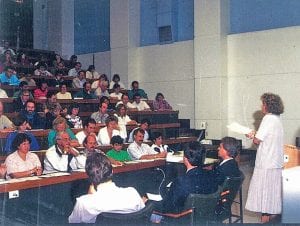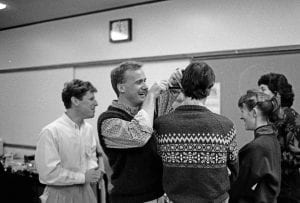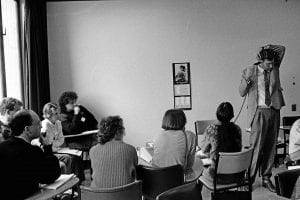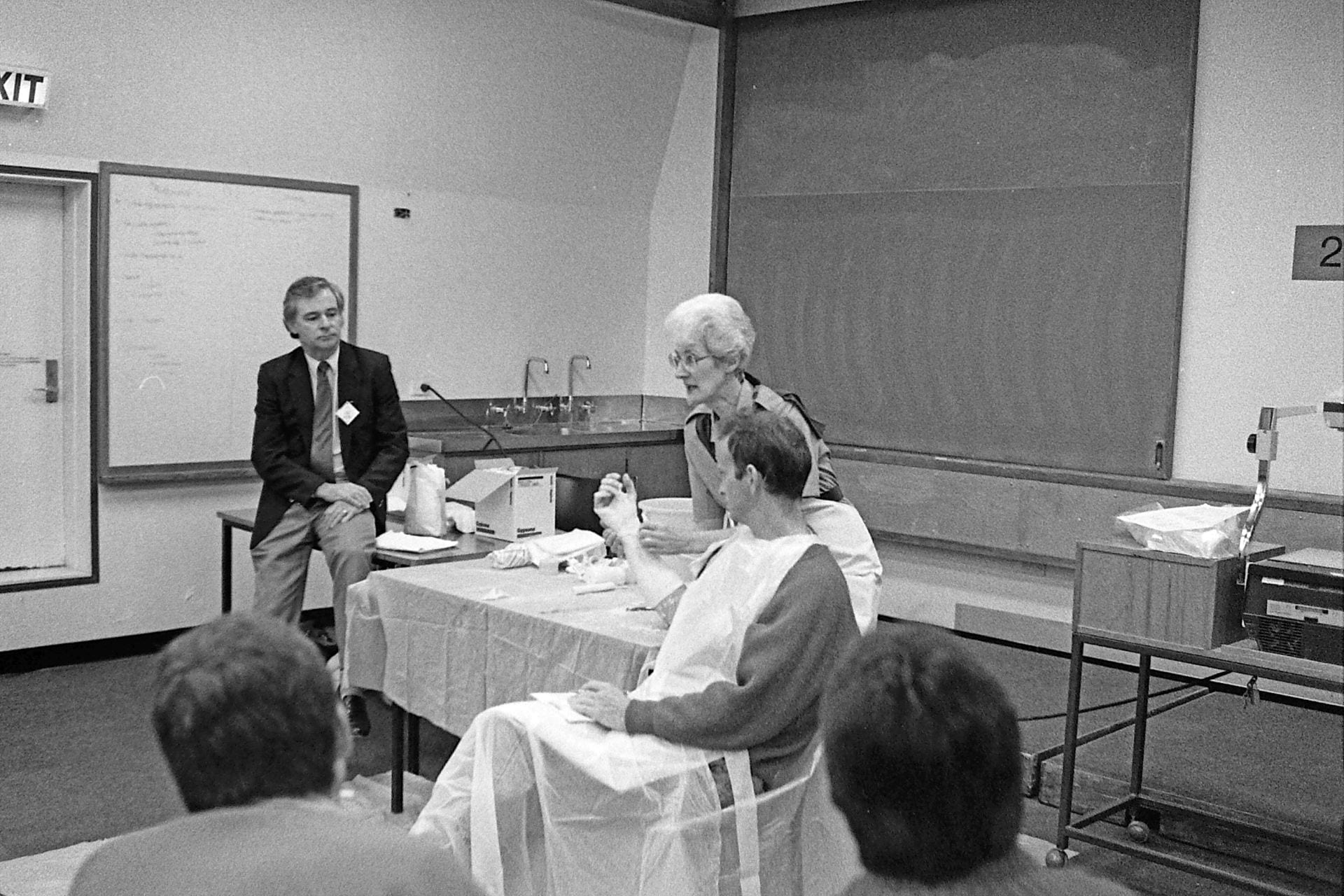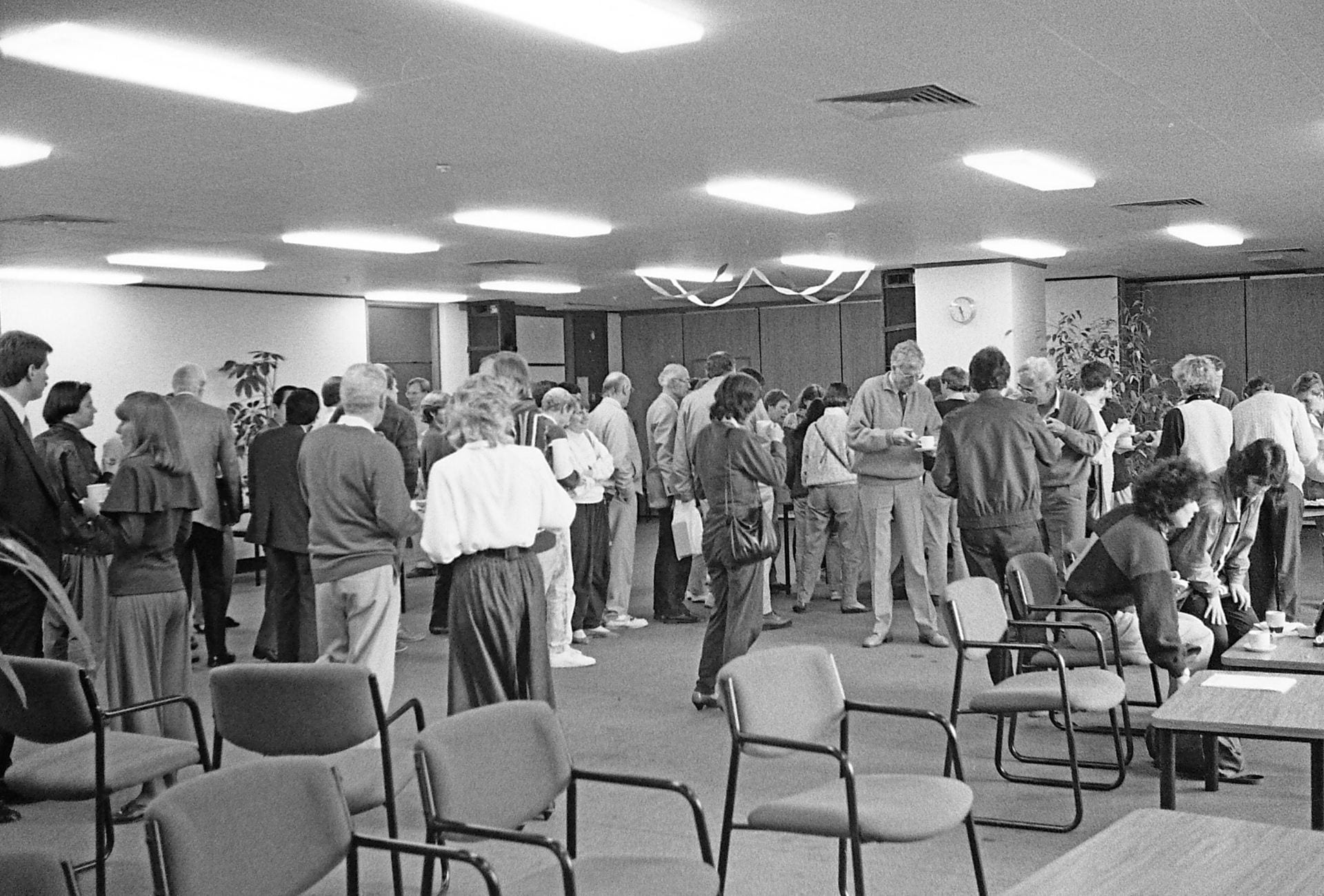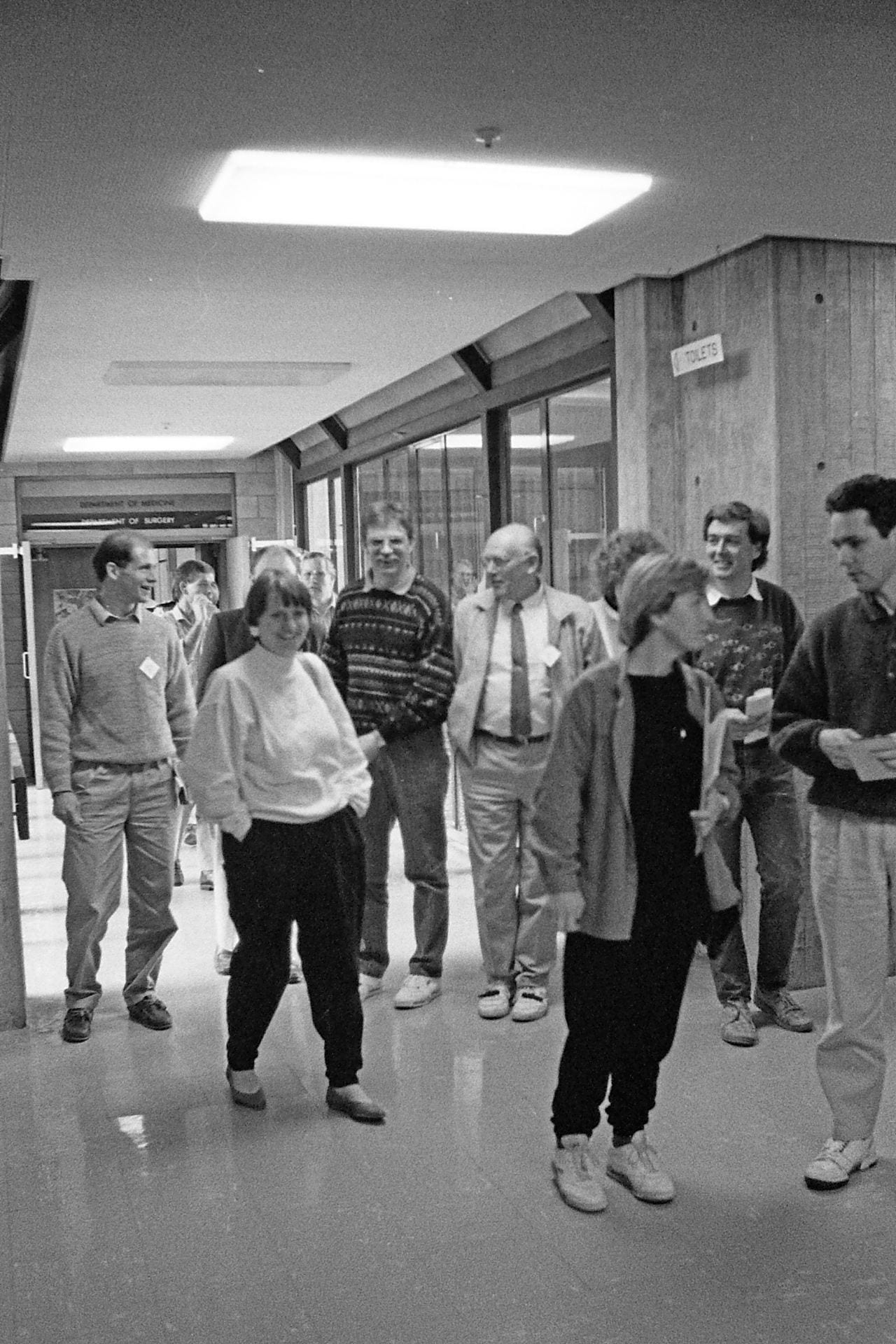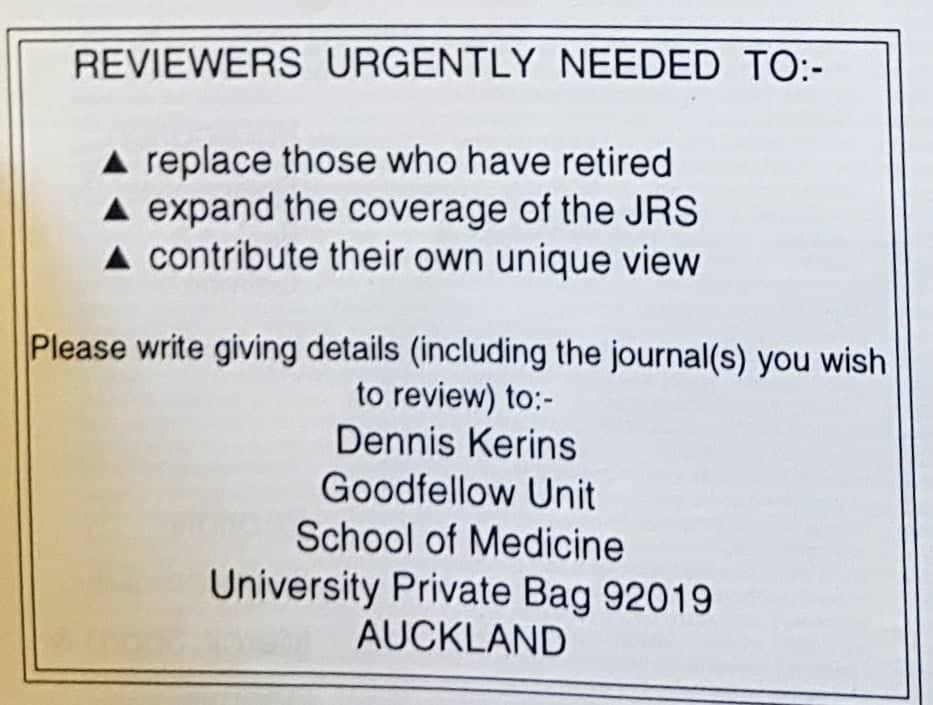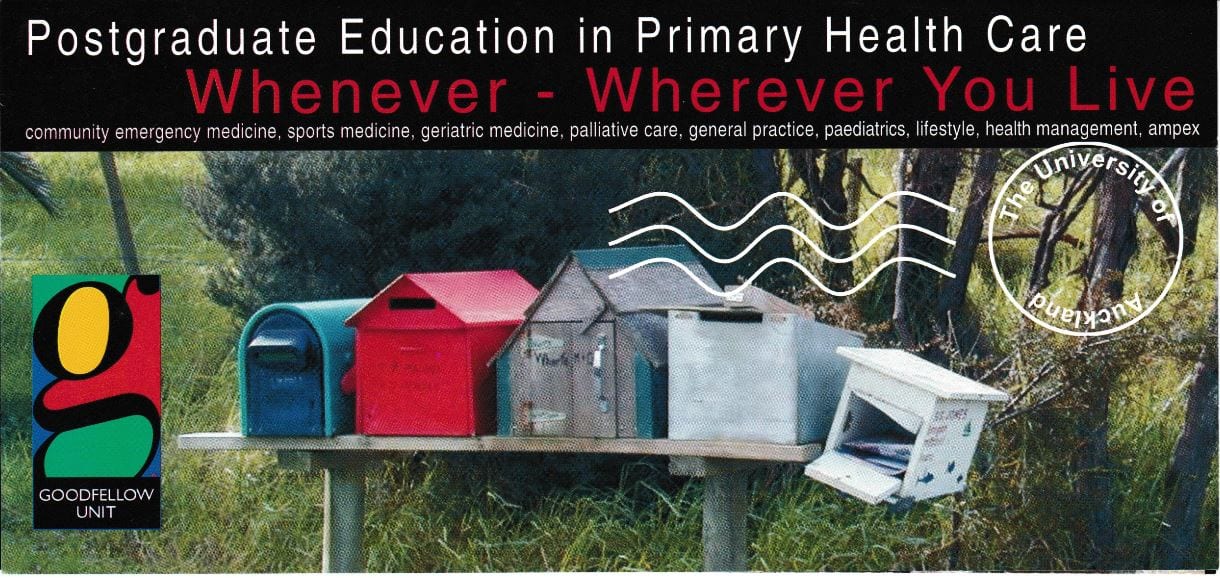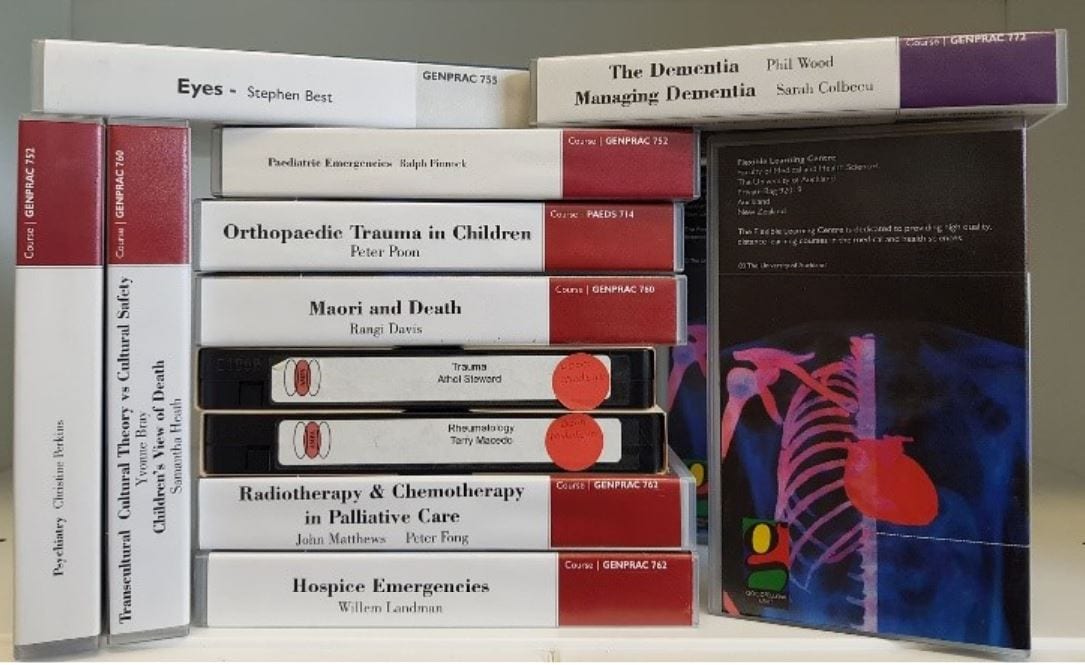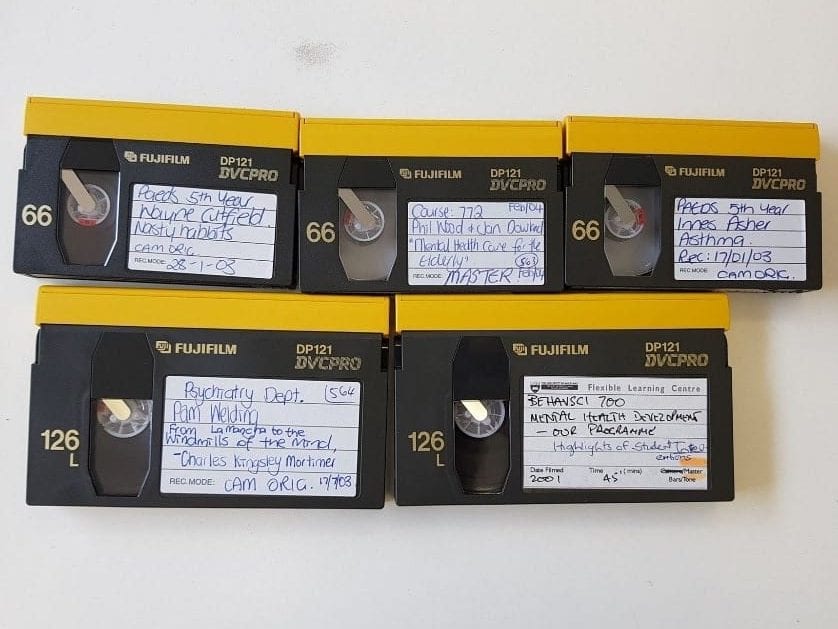Short Courses
From the late-1970s, the Goodfellow Unit emphasised meeting the needs of GPs and making continuing education interesting and accessible. By the end of 1979, which marked one year since he had commenced his position as the Director, Phil Barham had hosted over ten evening courses, four sessions on the role of physiotherapy in general practice, and one full day course on alcohol management.[1] These lecture-style courses followed a similar format to the other short courses each regional Postgraduate Society organised around New Zealand at that time.
Short courses initially took the form of lectures.
Yet many of those who participated in oral history interviews for this project remembered Barham’s determination to shift the short courses away from didactic teaching and towards more interactive learning. Dr Barham had reported his concerns with instructor-centred lectures during a session on ‘teaching in the practice’ at the Annual Medical Education Seminar of the Postgraduate Medical Committee at the University of Auckland in November 1975. He recounted conversations with house surgeons who had taken a full ‘two years to unlearn the passive student role with which they had become indoctrinated in undergraduate teaching’.[2] Instead, he encouraged part-time staff and volunteers to develop lessons that focused on encouraging active learner participation. This included organising sessions on improving attendees’ practical skills, problem-solving, and engaging attendees in small group discussions.
Short courses involved practical sessions whereby attendees practised new techniques on their peers. Images taken during a weekend course on clinical procedures, c. 1989.
The two-hour evening sessions or full-day weekend workshops proved to be popular among GPs. In 1982, Phil Barham reported that ‘almost despite ourselves [the courses] continue to increase in number, size, and range of topics’, and more than one third of GPs across the North Island attended at least one of the courses that the Goodfellow Unit organised in Auckland.[3]
In addition to emphasising peer-interaction during the sessions, Phil Barham and other staff aimed to ensure GPs had an active role in designing the courses and selecting topics that were of immediate relevance to their everyday practice. Campbell Maclaurin explained:
The tendency previously had been rather didactic teaching by specialists about their favourite areas of where they thought GPs failed, and Phil turned that around. […] All the activities were run by GPs and that was very different from having a physician or a paediatrician telling the GP what they needed to know, so much as the GP saying, ‘now this group of us here know damn well where there are gaps and we’ll recruit specialists as necessary to come and assist with it’. And they did. And it worked very well.[4]
Changing these sessions to focus on the specific needs of GPs required the organisers to allocate topics and assert time limits on the invited speakers. Jocelyn Tracey became the Deputy Director of the Goodfellow Unit in the early-1990s. She explained that the Goodfellow Unit staff received a lot of support from other GPs who volunteered their time to organise two-hour evening courses or weekend sessions to ensure the programmes focused on the needs of GPs. Jocelyn organised role-play sessions with GPs to practise negotiating with specialists they invited to present at the sessions:
We would do role-plays about how to interact with specialists. So if you ring up an orthopaedic surgeon and say, ‘we’re planning to do something about arthritis’, and the orthopaedic surgeon says, ‘Oh, I’ve just been off to a conference and I know the very latest type of hip replacement that you should be doing and what prosthesis you should be using’, our eyes would glaze over and we would say, ‘Well actually, that’s probably not what the GPs need to learn about. We would really like to know about arthritis and this and this: Would you be able to speak about that?’ And the specialist would say, ‘Well, that would take me at least two hours’. And then we’d say, ‘Well I’m sorry, you’ve only got fifteen minutes and then we want some problems to discuss based on your talk’. So that was the beginning of changing it from didactic ‘the specialist knows best’ to what the GPs really need to know and how to best learn. [5]
Jocelyn Tracey on training GPs to interact with specialists
Bruce Adlam also attested to the importance of engaging with specialists solely ‘as a resource person’ and rather drawing on the ‘knowledge that’s in the room’. Bruce had been part of the second intake into the University of Auckland School of Medicine in 1969 and had worked as a GP in the Bay of Plenty and as a locum in various hospitals in the UK, before returning to New Zealand and working as a general practitioner in Howick, Auckland.
He joined the Goodfellow Unit as a Course Facilitator in 1993 or 1994. By the early-1990s, Phil Barham had developed what he termed the ‘modified triadic method’ and hosted training sessions for course facilitators to encourage them to apply the method to their courses. Bruce Adlam described this as a ‘GP-ised’ version of the triadic method of teaching, which comprised the specialist, the course facilitator, and the other GPs who attended the courses. The modified triadic method involved GPs identifying their main questions, and then collectively working through the answers with guidance from the specialist.
Bruce Adlam on the Modified Triadic Method
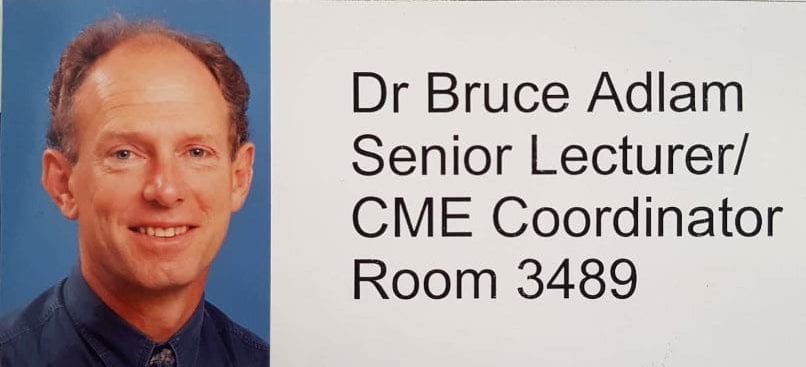
This style of teaching marked a clear departure from the other courses GPs had previously attended. Bruce explained, ‘We’d all been used to basically sitting in a chair, being talked at, going home, forgetting about it or knowing that there is something probably that I should be changing here but I’m not quite sure what’. Alternatively, the modified triadic method meant the techniques and skills they learned during the sessions ‘went straight from that discussion to being incorporated into your daily practice’.[6]

Some specialists certainly welcomed their limited roles in the sessions. Bruce recalled that the courses ‘were always really highly rated’ by both GPs and specialists, the latter of whom ‘would come back and say ‘Oh I really learned a lot today from that course, I didn’t realise what was happening in the GP world’.[7] John Wellingham concurred. John worked with the Goodfellow Unit from 1989 to 1999, first as a course facilitator and then as the Quality Assurance Director. He explained that these courses ‘brought specialists and general practice people, in my eyes, much closer together’.[8]
John Wellingham on the GFU courses
In addition to providing attendees with medical updates, from the mid-1990s course facilitators also focused on helping GPs to refine their communication skills during consultations with patients. Bruce’s colleague, Dr Marc Shaw had experience writing and directing plays and was a key influence in introducing the use of role-plays to the sessions. They hired actors to adopt the persona of the ‘difficult teenager’ during simulated consultations with GPs who attended the Goodfellow Unit courses.
Bruce described the debrief session at the end of the role-play as the ‘most powerful part of that learning’:
It wasn’t necessarily how successful you were in terms of your interview technique, but it was actually listening to what those role players would say when they had to answer ‘How are you like this person?’ ‘How are you not like this person?’ And the third question was, ‘What would your wise words be to me as the GP?’ So those were all really interesting take-home messages. They would say little things like, ‘Oh you fidget, or you’re clicking your pen, or I can see you’re interested but you’re just not on the right wavelength’. So those kinds of things were actually really helpful.
The short courses not only offered attendees some of the first continuing medical education sessions that were designed by GPs for GPs, but they also offered attendees important opportunities to meet and engage with their peers. In 1981, Phil Barham and research assistant John Benseman reported that short courses were especially popular among GPs who had few opportunities to discuss medicine with colleagues. These included those who worked in solo practices and those geographically isolated from the main hospitals.[9]
Associate Professor Nikki Turner, currently Director of the Immunisation Advisory Centre (IMAC) and Associate Professor in the University of Auckland’s Division of General Practice and Primary Health Care, attested to the ‘collegiality and social engagement’ she experienced during the short courses she attended in the early-1990s. Nikki had started to attend the courses as a ‘very junior doctor’ who had recently returned to New Zealand after several years overseas. She described the short courses as a place ‘where I felt like I was securely getting the support and backup as a part time GP to be safe’. As a GP who had ‘been out of the country for quite a while, it was quite nice to re-engage. It gave you community networks and it gave you skills and knowledge and support.’[10]
The short courses met an important need for GPs who wanted to develop their skills and to engage with their peers. The attendance fees also generated a small income for the Unit. In the early-1990s, the Goodfellow Unit charged attendees $22 for evening sessions, and $110 for members or $165 for non-members to attend the weekend sessions. Barham reportedly described the fees as ‘chicken-feed by international standards’.[11] Nevertheless, the courses faced serious competition from the sessions pharmaceutical companies had organised that were free of charge and often included complimentary meals.
Many Goodfellow attendees praised the courses for operating independently from pharmaceutical companies and the biases they associated with such sponsored meetings. The risk of competition from other providers did not materialise in full until the early-2000s.
As Ross McCormick, the Director of the Goodfellow Unit from 1998 to 2008, explained, by the early-2000s ‘the short courses were starting to get into trouble, the numbers were dropping’. Primary Health Organisations across Auckland and beyond offered short courses free of charge, and ‘people were going off to them because they were free and we weren’t’.[12]
The geographical location of the Goodfellow Unit posed another barrier to attendance. In February 2004, the Goodfellow Unit relocated from Griffin House, where it had been based since 2000, to the University of Auckland’s Tamaki Campus. The shift offered the Unit with opportunities for growth and engagement with local businesses.[13] Yet many potential course attendees preferred to attend sessions at their work places rather than travelling to the new campus.
Ross McCormick subsequently decided to discontinue the courses for twelve to eighteen months. While his decision to do so reduced the cost of the Unit, it ‘felt like a disaster’ to stop hosting them. He questioned, ‘How can we be the Goodfellow Unit if we aren’t running short courses?’[14]
Ross initially planned to re-establish the courses as they were ‘part of our core business’. Yet a timely phone call from Andrew Wong from Mercy Ascott and the subsequent establishment of the Goodfellow Symposiums offered the Unit with a viable alternative to re-establishing the courses. In this regard, ‘the Symposium saved us’.
The Introduction of Flexible Learning
The short face-to-face courses proved to be popular among GPs across the top half of the North Island. Yet the travel time and cost required to attend the courses meant they were not always
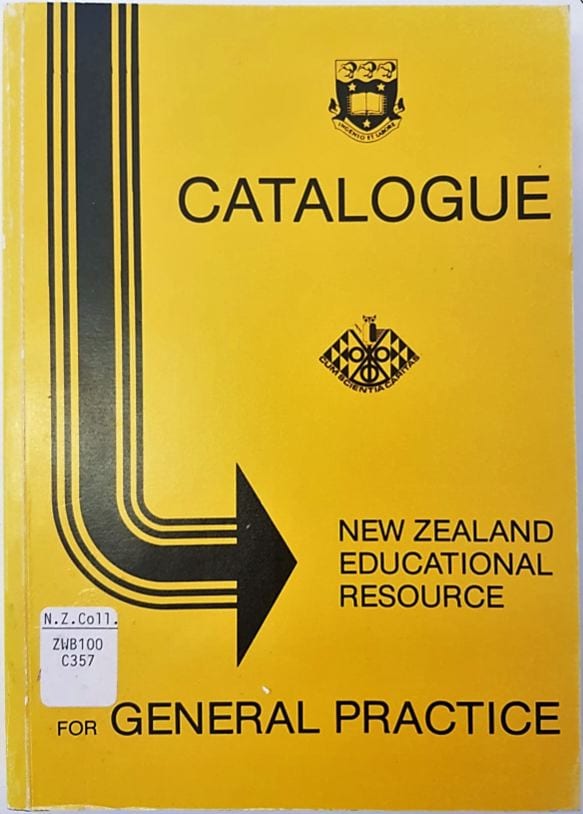
accessible for GPs who wanted to participate in the sessions. In 1982, Barham raised particular concerns about the limitations of existing continuing medical education for women GPs. He reported that the ‘combined roles of general practitioner, mother, wife and home manager put very real limits on women’s time and energy.’ [15] He anticipated that ‘our present social structures will continue to provide very real constraints’ on the abilities of women to participate in further education.
Women GPs’ attendance at the short courses reflected the enthusiasm with which many women pursued continuing medical education. Phil Barham’s 1982 annual report indicated that while women comprised nine percent of GPs in New Zealand, they represented nearly seventeen percent of the attendees at short courses. This rate was over double the number of women who attended the first courses the Unit had offered four years earlier in 1978. Phil Barham aimed to engage with the needs of women GPs. He invited women medical graduates to complete questionnaires and to attend two meetings to discuss the limitations of existing continuing medical education.
Considering some GP’s struggles to access onsite education, the introduction of distance learning was an especially noteworthy venture. With support from Margaret Gibson Smith, a staff member at the Philson Library within the University’s Faculty of Medical and Health Sciences, Phil Barham established the New Zealand Educational Resource in 1979.[16] This mail order system enabled GPs to borrow books, journals, audio, and video cassettes from the Philson Library. They received the resources via mail delivery and could listen to cassettes in their cars during the commute to work, or watch the education videos at home. With external grants from The Butland Charitable Trust and the NZ Medical Education Trust in 1984, the Unit also produced new interactive videos and audio cassettes for small group sessions and for individuals learning by distance.[17]
The Goodfellow Unit’s emphasis on making medical updates accessible to GPs was also clear through the establishment of the Journal Review Service. In 1982, Phil Barham appointed Mary Hepple as the Director of Education Resource. Mary Hepple took responsibility for updating the Educational Resource and sourcing suitable material for video production. With financial support from the NZ Medical Education Trust, she also established the Journal Review Service within the Goodfellow Unit. This involved approaching GPs to write short summaries and comments about journal articles they had read. She then indexed, edited, and printed the reviews to circulate to GPs who could request photocopies of the original articles they wished to read from the Department of Postgraduate Affairs in which the Goodfellow Unit was located.
Mary Hepple left the Goodfellow Unit in the mid-1980s. Simon Oliver took over the Journal Review Service, followed by Dennis Kerins from June 1989.
Phil Barham reported that the Journal Review Service was an attempt to overcome the ‘problems of information overload’ that GPs faced as a result of the ‘ever-increasing quantity of professional reading’.[18] By 1984, about twenty-five GPS from around NZ volunteered their time to read and review journal articles that they believed to be of relevance to other general practitioners, and nearly 450 GPs reported using the service.[19] The popularity of the Journal Review Service continued to grow across the late-1980s and 1990s. By 1989, the Goodfellow Unit had sold quarterly issues of the Journal Review Service to Australia for the cost of $40, 000 per annum.[20] In 1994, the Journal Review Service became a regular feature of the New Zealand Family Physician, the journal of the Royal New Zealand College of General Practitioners, with pharmaceutical companies sponsoring publication and reprints.
Postgraduate Diplomas
When Campbell Maclaurin proposed the programme that became the Goodfellow Unit to Douglas Goodfellow in 1977, he did not intend to offer formal qualifications but rather focused on providing continuing medical education for GPs. By the early-1990s, however, attendees became interested in learning more about specific areas of general practice and gaining a formal qualification to attest to their skills.[21]
The existing ‘cross fertilisation and good professional relationship’ between staff in the Goodfellow Unit and in the Department of General Practice perhaps aided the development of these courses.[22] Staff from the Goodfellow Unit and the Department of General Practice were located on the same floor at the University of Auckland’s Grafton Campus. They often shared offices, contributed to one another’s meetings, and assisted on one another’s selection panels for new appointments. Phil Barham also contributed to the undergraduate teaching programmes in General Practice at no additional cost to the University of Auckland.[23] Campbell Maclaurin and Phil Barham cited this ‘close de facto relationship … with regular twice weekly meetings and input into the planning of the various activities of that department’ as a main reason for transferring Goodfellow Unit from the Department of Postgraduate Affairs to the newly formed Department of General Practice in 1987.[24]
The importance of this relationship is perhaps most clear through the administration of postgraduate diplomas. In 1993, staff at the Goodfellow Unit established a year-long course in sports medicine, which involved a combination of evening lectures and clinical sessions from February to November, a series of half-day attachments, and a written and practical assessment. They also began a course on community emergency medicine, with weekly evening courses, and established a course on geriatric medicine shortly afterward.[25] Although the Goodfellow Unit could not award postgraduate qualifications – instead, students received their qualifications from the Department of General Practice – the Unit organised most of the teaching of these courses on behalf of the University of Auckland.[26]
The Goodfellow Unit promoted their courses during the University of Auckland’s first Open Day on 14 and 15 September, 1996. They arranged the display in partnership with the 1st Field Ambulance Army Medical Corps, comprised of fourth and fifth year medical students.
The Unit’s decision to launch the courses reflected broader cultural changes. The former Assistant Director Jocelyn Tracey explained they established the Diploma of Community Emergency Medicine in response to the ‘call from GPs’ who needed more specialist training with the rise of emergency medicine clinics. Along similar lines, they decided to establish the Diploma in Sports Medicine in response to the ‘increasing emphasis on sports medicine in general practice but unless GPs went overseas there was no training available. So that’s why we set up a diploma’.[27]
The Goodfellow Unit not only responded to GPs educational needs regarding the content of the courses and formal recognition but also sought to make these courses accessible to GPs around the country by offering distance education. As noted earlier, distance learning had been an important feature of the Goodfellow Unit since 1979 when GPs could request interactive videos and audio cassettes through the Philson Library at the University of Auckland’s School of Medicine.
Promotional pamphlet for distance education. Photo taken by Dennis Kerins at Mangawhai Heads.
In the 1990s, GPs reported travelling over two hours each week to attend the thirty two-hour seminars required to complete their diplomas. Consequently, the Goodfellow Unit offered diploma papers in community emergency medicine, sports medicine, and geriatric medicine by distance for the first time in 1995.[28]
A selection of videos and DVC-Pro tapes the Goodfellow Unit co-produced with the Faculty of Medical and Health Sciences Media Unit.
Across the early-2000s, the postgraduate diplomas expanded from catering to the needs of GPs, to attracting others working in primary care including nurses and pharmacists from New Zealand and overseas. They featured workbooks, videos, CDs, and later, web-based discussion groups and web-based case studies. [29]
By 2012, the Goodfellow Unit delivered all courses online, with the exception of some sections on practical skills that took place in workshops.
The CME Club
The early-2000s also witnessed the growth of online education, especially with the Goodfellow CME Club website. The website provided registered GPs and other health professionals with access to the Journal Review Service, virtual courses, case studies and a series of ‘hot tips’. It also featured up-to-date information on assessing and managing selected health conditions.[30]
Dennis Kerins, the then Education Resource Coordinator at the Goodfellow Unit, first conceived of the idea of a Goodfellow Club in 1998. It gained momentum in the early-2000s when it received financial support from the Goodfellow Foundation.
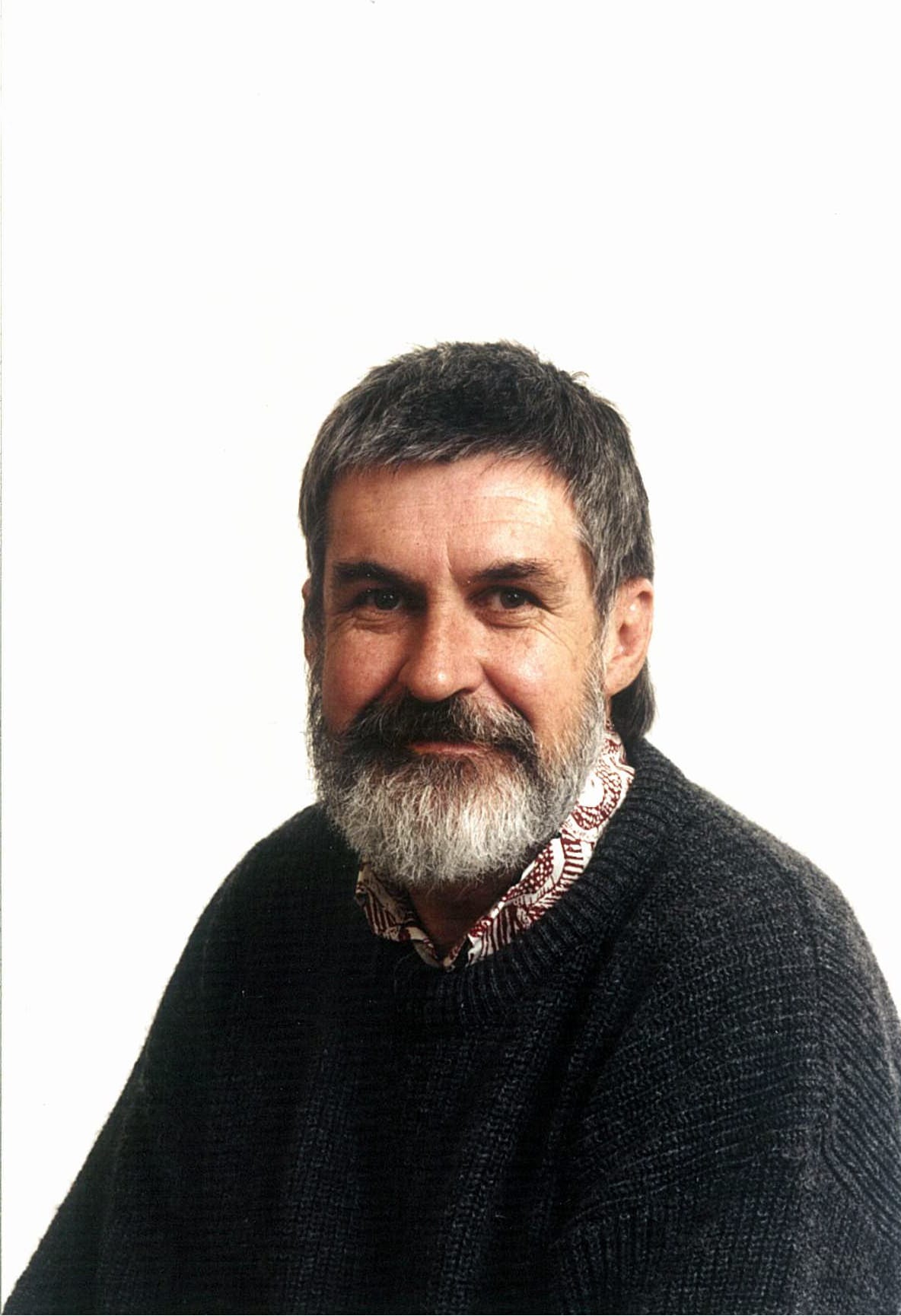
The scope of the CME Club, however, was initially limited due to the low number of GPs who used the internet. In 2000, Goodfellow Unit staff estimated that one quarter of the GPs who attended the courses regularly used the internet or email. Attendees also reported the internet was their least preferred learning format.[31] The following year in 2001, Goodfellow Unit staff found that attendees viewed any form of continuing medical education that did not involve face-to-face interaction with their peers as ‘adjunctive’. While some rural GPs reportedly ‘liked the concept’ of the CME Club, most attendees had limited knowledge and use of the website.[32]
Support from the Royal New Zealand College of General Practitioners appears to have fuelled the appeal of the CME Club across the early-2000s. In September 2000, College had endorsed the CME Club as a continuing medical education provider whereby members could gain re-accreditation credits by completing the virtual courses and quizzes.[33] By October 2003, over six hundred GPs across New Zealand had registered with the online CME Club.[34] In addition to the value of obtaining CME points, users highlighted many advantages of using web-based learning including flexibility, accessibility, the richness of content, and up-to-date information.[35]
Across the early-2000s, staff developed innovative ways to encourage people to visit and register with the site. In July 2004, the New Zealand Doctor announced they had collaborated with the Goodfellow Unit to help readers to gain CME points. Readers could earn two CME points and a certificate by completing the Unit’s online quiz that supplemented the magazine’s ‘How To Treat’ section.[36] By 2008, as one reviewer in the New Zealand Doctor reported, the ‘website has evolved with a sophisticated, simple and user-friendly quiz and explanation format which is easy to use and gives scored feedback and also the ability to provide auto driven CME Certificates in PDF format’.[37] By that time, the CME club had over 1500 members.
Over the following years, the CME club grew to include material for others working in health, namely physiotherapists and nurses, as well as other doctors who worked outside of general practice.[38]
[1] Philip Barham, Annual Report of the Sir William Goodfellow Director of Continuing Medical Education in General Practice, 31 December 1979, 3.
[2] ‘Teaching in the Practice, Fish Bowl Session’, New Zealand Family Physician vol 3, no 3 (1976): 30.
[3] Philip Barham, Annual Report of the Sir William Goodfellow Director of Continuing Medical Education in General Practice, 31 December 1982.
[4] Interview with Campbell Maclaurin, 11 September 2018.
[5] Interview with Jocelyn Tracey, 31 October 2018.
[6] Interview with Bruce Adlam, 12 December 2018.
[7] Ibid.
[8] Interview with John Wellingham, 22 November 2018.
[9] Philip Barham and John Benseman, The General Medical Practitioner as a Lifelong Learner: Realities and Prospects. An Exploratory Study of Continuing Medical Education (CME) Among General Medical Practitioners in the University of Auckland Area (Auckland: Department of Postgraduate Affairs, University of Auckland, 1981), 74.
[10] Interview with Nikki Turner, 14 November 2018.
[11] Carmel Williams, ‘User Pays Marks the End of a Philanthropic Era’, New Zealand Doctor, 19 March 1992, 56
[12] Interview with Ross McCormick, 2 November 2018.
[13] Ross McCormick, Report On Goodfellow Unit Strategic Planning Day, 22 May 2003.
[14] Interview with Ross McCormick.
[15] Philip Barham, Annual Report of the Sir William Goodfellow Director of Continuing Medical Education in General Practice, 31 December 1982.
[16] Annual report of the Sir William Goodfellow Director of Contuning Medical Education in General Practice for the year ending 31 December 1979, Philip Barham. P. 4.
[17] Annual report of the Sir William Goodfellow Director of Contuning Medical Education in General Practice for the year ending 31 December 1984, Philip Barham, p. 2.
[18] John Benseman and Philip Barham, ‘Coping with Information Overload: The Development and Evaluation of a Journal Review Service’, Medical Education vol 18 (1984): 446.
[19] Philip Barham, Annual Report of the Sir William Goodfellow Director of Continuing Medical Education in General Practice, 31 December 1984.
[20] Philip Barham, Goodfellow Unit, Moves Towards Self Sufficiency by 1993, November 1989, 2.
[21] Interview with Jocelyn Tracey; Claire J. McLachlan-Smith and Jocelyn M. Tracey, ‘Learning by Distance for General Practitioners: Students’ Experiences of Goodfellow Unit Diplomas’, New Zealand Medical Journal vol 113, no 1110 (2000): 188
[22] Interview with Brian McAvoy, 2 November 2018.
[23] Philip Barham, Goodfellow Unit, Moves Towards Self Sufficiency by 1993, November 1989, 2.
[24] Letter from Campbell Maclaurin and Philip Barham to Colin Maiden, 3 November 1987.
[25] Philip M. Barham, ‘Long Courses Offered from Goodfellow Unit’, New Zealand Doctor, 15 April 1993, 32
[26] Report on Goodfellow Unit Strategic Planning Day, 22 May 2003.
[27] Interview with Jocelyn Tracey.
[28] Mclachlan-Smith and Tracey, ‘Learning by Distance for General Practitioners’, 187-9.
[29] Ross McCormick, Postgraduate Annual Report, draft, 2003.
[30] Rajesh Kumar, ‘One in Five GPs Drop by Goodfellow’s “Club Med”’, New Zealand GP, 15 October 2003.
[31] McLachlan-Smith and Tracey, ‘Learning by Distance for General Practitioners’, 189.
[32] Felicity Goodyear-Smith, Melanie Whitehorn, and Ross McCormick, ‘Experiences and Preferences of General Practitioners Regarding Continuing Medical Education: A Qualitative Study’, New Zealand Medical Journal vol 116 no 1172 (2003): online.
[33] Ross McCormick, Report to the Goodfellow Foundation, draft, 20 October 2003.
[34] Kumar, ‘One in Five GPs Drop by Goodfellow’s “Club Med”’.
[35] McCormick, Report to the Goodfellow Foundation.
[36] ‘Scoring CME with How to Treat and the Goodfellow Unit’, New Zealand Doctor, 28 July 2004, 24.
[37] Jon Wilcox, ‘Take a bow, Goodfellow Club’, New Zealand Doctor, 24 September 2008.
[38] Ross McCormick, Report to the Goodfellow Foundation, 4 October 2007, 6.


